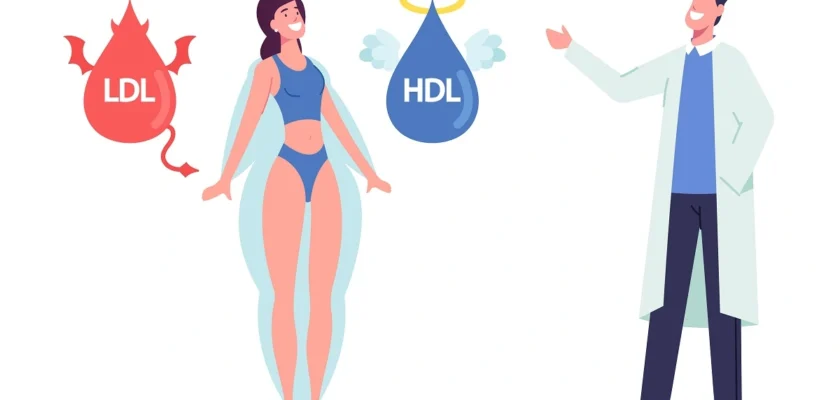Cholesterol is an issue that many people face in the world. The word cholesterol in itself has become such a negative term when in fact, cholesterol is required by human bodies. They help build essential fat supplies, store energy and provide warmth to the body.
They are essential for brain and heart health and, in moderate quantities, are great for skin, hair and nails. It becomes an issue only when there is too much bad cholesterol in the blood, which is present in junk food and processed foods.
A cholesterol test helps reveal how much cholesterol is present in the blood and its various types and percentages in the blood. So, get ready to dive into the world of lipids and discover what your cholesterol panel says about your health!
Unveiling the Mystery: Demystifying the Terminology
To understand your cholesterol panel, it’s important to grasp the terminology. Here are the key terms you need to know:
- Total Cholesterol: This refers to the sum of all cholesterol in your bloodstream.
- LDL (Low-Density Lipoprotein) Cholesterol: Often called the “bad” cholesterol, LDL takes cholesterol from the liver to the cells. Higher LDL levels are associated with an increased risk of heart disease.
- HDL (High-Density Lipoprotein) Cholesterol: HDL, also known as the “good” cholesterol, helps clear extra cholesterol from your bloodstream and transports it back to the liver for disposal.
- Triglycerides: These are a type of fat found in the blood. Elevated triglyceride levels can contribute to heart disease.
The Numbers Game: Decoding the Numbers
Now that the terminology is demystified, here’s a look into the numbers on your cholesterol panel. These numbers provide valuable insights into your cholesterol levels. Here’s what you need to know:
- Desirable Levels: For a healthy lipid profile, your total cholesterol should be lower than 200 mg/dL, LDL cholesterol less than 100 mg/dL, HDL cholesterol more than 60 mg/dL, and triglycerides less than 150 mg/dL.
- The Optimal Ratio: Calculating the ratio of total cholesterol to HDL cholesterol helps assess your risk of heart disease. Ideally, the ratio should be less than 5:1, preferably closer to 3.5:1.
Encounters with the Lipid Panel: A Surprising Wake-Up Call
- Many individuals are taken aback when they receive the results of their cholesterol panel. It serves as a wake-up call to prioritise their health. The reports can be overwhelming, with many numbers and medical jargon to decipher.
- One might find their total cholesterol level alarming, reaching 240 mg/dL or higher. Thoughts of heart attack and blocked arteries may flood their mind. Furthermore, their LDL cholesterol levels may exceed 160 mg/dL. Although within the recommended range, the HDL cholesterol level cannot overshadow the looming threat of high cholesterol. Lastly, an unwelcome surprise may come from elevated triglycerides, surpassing 180 mg/dL.
The Journey Towards Change: Taking Charge of Your Health
Facing the truth about your cholesterol levels is a wake-up call. You don’t have to let the numbers dictate your fate. It’s time to take control of your health and embark on a journey towards change.
To start, seek advice from your doctor and nutritionist. They will emphasise the importance of lifestyle modifications and a heart-healthy diet. Here are the steps you can take:
- Cutting Down on Saturated Fats: Bare farewell to high-fat foods like cheeseburgers and embrace lean proteins such as fish and skinless poultry.
- Embracing Heart-Healthy Fats: Incorporate avocados, nuts, and olive oil into your diet as allies in the fight against high cholesterol.
- Exercising Regularly: Say goodbye to sedentary habits and introduce brisk walks and cardio workouts into your daily routine.
- Shedding Those Extra Pounds: Prioritise weight loss, as excess body fat can increase cholesterol levels.
The Power of Persistence: Change Takes Time
Change doesn’t happen overnight, and the journey towards a healthier lipid panel requires persistence. It takes weeks of discipline, commitment, and occasional setbacks. There will be days when you crave indulgent foods or feel tempted to skip your workout. However, keep the bigger picture in mind—the long-term benefits of a healthy cholesterol panel.
The Road to Redemption: A Second Chance
- Armed with newfound knowledge and determination, undergo a follow-up lipid panel. The results may bring a sense of anticipation and anxiety. Upon receiving the report, you might experience a rush of relief and satisfaction.
- Your total cholesterol may have dropped to 170 mg/dL, within the desirable range. The once worrisome LDL cholesterol would decrease to 80 mg/dL. Your HDL cholesterol might also increase to 70 mg/dL, moving closer to the optimal range. Even your triglycerides may normalise, registering at 120 mg/dL.
- This sense of accomplishment proves that with determination, lifestyle changes, and a sprinkle of luck, you can rewrite your health narrative.
Conclusion: Embrace the Challenge and Journey Towards a Healthier You
Understanding your cholesterol test is a crucial step in maintaining a healthy heart. Your journey with high cholesterol reminds you of the importance of taking charge of your health, embracing change, and persisting despite setbacks. So, the next time you encounter your cholesterol panel, remember that it’s not just a set of numbers but a story waiting to be told. Embrace the challenge, make informed choices, and embark on a journey towards a healthier you.

